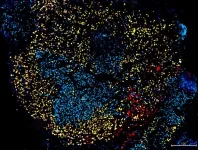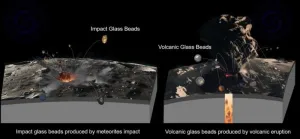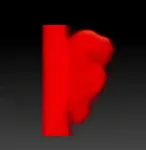New York, NY [September 5, 2024]—A novel study by researchers at the Icahn School of Medicine at Mount Sinai addresses a critical yet under-explored question in cancer research: Why is aging the biggest risk factor for cancer? The study reveals how an aging immune system spurs tumor growth, offering new insights into cancer prevention and treatment, especially for older adults.
Details on the findings were reported in the September 5 Online First Release of Science [DOI:10.1126/science.adn0327]. In preclinical models, the research team found that anakinra, a drug typically used for inflammatory conditions such as rheumatoid arthritis, can be repurposed to block harmful signals between early lung cancer lesions and the bone marrow. This is critical, say the investigators, because as the immune system ages, it creates harmful inflammation that can drive cancer development.
“As the immune system ages, it triggers harmful inflammation that can drive cancer growth––by promoting the accumulation of pro-tumor macrophages, a type of immune cell that suppresses the immune effector cells that normally kill tumor cells. This weakens the body's ability to fight cancer," says lead author Matthew D. Park, PhD, a sixth-year Icahn Mount Sinai MD/PhD student in the lab of Miriam Merad, MD, PhD, senior corresponding author of the study.
"We found that by blocking specific inflammatory pathways, especially those involving molecules called interleukin-1⍺ (IL-1⍺) and IL-1β, this damaging process could be reversed in mouse models, offering a potential new approach to preventing cancer development in humans,” says Dr. Merad, Dean for Translational Research and Therapeutic Innovation, Director of the Marc and Jennifer Lipschultz Precision Immunology Institute, and Chair of Immunology and Immunotherapy at Icahn Mount Sinai.
Signaling between early lung cancer lesions and immune stem cells in bone marrow via IL-1⍺/β underscores how an aging immune system promotes cancer progression. Shown in yellow and blue are tumor cells that express the receptor for IL-1⍺/β and those that do not, respectively. Reprinted with permission from Park et al., Science 10.1126/science.adn0327 (2024)
Cancer is a disease that becomes increasingly common as we age, with the risk rising sharply after the age of 60. Many theories have been proposed, including the cumulative effects of environmentally-induced damage and genetic mutations, but there has been little concrete data explaining why aging drives cancer, say the researchers.
As part of the study, the research team used mouse models to investigate how aging affects cancer progression. They injected tumor cells into mice and observed that lung, pancreatic, and colonic cancer grew more rapidly in older mice compared to younger ones. Using bone marrow transplants from either young or old mice, the investigators simulated the effects of the immune system’s aging. The team found that an aged immune system accelerates cancer growth, even in young mice. More strikingly, they found that rejuvenating the immune system significantly reduced cancer growth in older mice.
Using high-dimensional analysis of murine and human cancer tissues, the team identified specific cells and immune-related factors that accelerate cancer growth in the elderly. They then successfully blocked these factors, specifically IL-1⍺/β, demonstrating that inhibiting these molecules can reduce cancer growth in aged mice.
“Our study shows that an aged immune system promotes cancer progression, independent of the age of the cancer cells or the surrounding tissue. We've long suspected that inflammation can suppress anti-tumor immunity, particularly in older individuals and cancer patients. However, this is the first robust evidence proving that chronic inflammation from an aging immune system predisposes to cancer,” says Dr. Merad. “This research not only brings our lab into the field of immune aging but also lays the groundwork for future studies, exploring its links to cancer and other aging-related conditions like cardiovascular disease and infections.”
“This study reveals that targeting the aging immune system could significantly reduce cancer risk in older adults. It suggests that enhancing the immune response through immunotherapy might be more effective than directly targeting tumors. The discovery that anakinra, which blocks the activity of IL-1⍺/β and is a drug already used for inflammatory conditions, can mitigate the harmful effects of immune aging on cancer opens the door to repurposing existing medications for cancer prevention,” says co-senior author Thomas Marron, MD, PhD, Director of the Early Phase Trial Unit at Mount Sinai’s Tisch Cancer Institute. “We’re now focused on translating these findings into clinical practice. Based on these results, we have now designed early-phase clinical trials to use anakinra in high-risk patients.”
The ongoing trials are investigating whether targeting the immune system can prevent cancer progression, while the researchers continue to explore additional therapeutic targets. Their ultimate goal is to develop preventive measures that reduce harmful inflammation in older adults, thus significantly reducing the incidence of cancer.
The paper is titled “Hematopoietic aging promotes cancer by fueling IL-1⍺-driven emergency myelopoiesis.”
Please see the paper [DOI:10.1126/science.adn0327] to view the remaining authors, more details on the paper, and competing interests.
The study was made possible by funding from the National Institutes of Health/National Cancer Institute, the Feldman Foundation, the Samuel Waxman Cancer Research Foundation, and American Federation for Aging Research; HFSP Postdoctoral Fellowship (LT00110/2015-L/1); AACR-AstraZeneca Immuno-oncology Research Fellowship (20-40-12-CASA, 21-40-12-MATT); Swiss Cancer Research Foundation (KFS-4724-02-2019 BIL) and Swiss National Science Foundation (SNSF PostDoc Mobility Fellowship P400PM_186740); Cancer Research Institute Irvington Fellowship (CRI4641); Cancer Research Institute/Bristol-Myers Squibb Irvington Postdoctoral Research Fellowship to Promote Racial Diversity (award no. CRI3931); and National Cancer Institute predoctoral-to-postdoctoral fellowship (award no. K00 CA223043).
-####-
About the Icahn School of Medicine at Mount Sinai
The Icahn School of Medicine at Mount Sinai is internationally renowned for its outstanding research, educational, and clinical care programs. It is the sole academic partner for the eight- member hospitals* of the Mount Sinai Health System, one of the largest academic health systems in the United States, providing care to a large and diverse patient population.
Ranked 13th nationwide in National Institutes of Health (NIH) funding and among the 99th percentile in research dollars per investigator according to the Association of American Medical Colleges, Icahn Mount Sinai has a talented, productive, and successful faculty. More than 3,000 full-time scientists, educators, and clinicians work within and across 44 academic departments and 36 multidisciplinary institutes, a structure that facilitates tremendous collaboration and synergy. Our emphasis on translational research and therapeutics is evident in such diverse areas as genomics/big data, virology, neuroscience, cardiology, geriatrics, as well as gastrointestinal and liver diseases.
Icahn Mount Sinai offers highly competitive MD, PhD, and Master’s degree programs, with current enrollment of approximately 1,300 students. It has the largest graduate medical education program in the country, with more than 2,000 clinical residents and fellows training throughout the Health System. In addition, more than 550 postdoctoral research fellows are in training within the Health System.
A culture of innovation and discovery permeates every Icahn Mount Sinai program. Mount Sinai’s technology transfer office, one of the largest in the country, partners with faculty and trainees to pursue optimal commercialization of intellectual property to ensure that Mount Sinai discoveries and innovations translate into healthcare products and services that benefit the public.
Icahn Mount Sinai’s commitment to breakthrough science and clinical care is enhanced by academic affiliations that supplement and complement the School’s programs.
Through the Mount Sinai Innovation Partners (MSIP), the Health System facilitates the real-world application and commercialization of medical breakthroughs made at Mount Sinai. Additionally, MSIP develops research partnerships with industry leaders such as Merck & Co., AstraZeneca, Novo Nordisk, and others.
The Icahn School of Medicine at Mount Sinai is located in New York City on the border between the Upper East Side and East Harlem, and classroom teaching takes place on a campus facing Central Park. Icahn Mount Sinai’s location offers many opportunities to interact with and care for diverse communities. Learning extends well beyond the borders of our physical campus, to the eight hospitals of the Mount Sinai Health System, our academic affiliates, and globally.
-------------------------------------------------------
* Mount Sinai Health System member hospitals: The Mount Sinai Hospital; Mount Sinai Beth Israel; Mount Sinai Brooklyn; Mount Sinai Morningside; Mount Sinai Queens; Mount Sinai South Nassau; Mount Sinai West; and New York Eye and Ear Infirmary of Mount Sinai.
END




